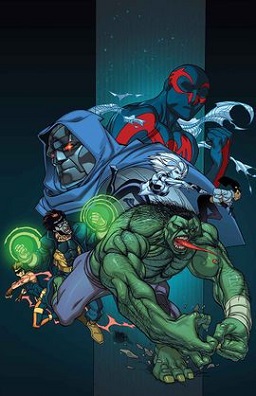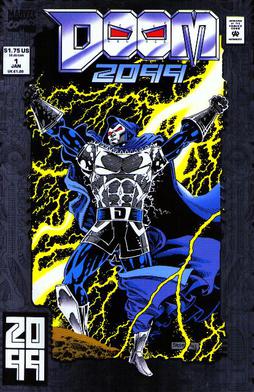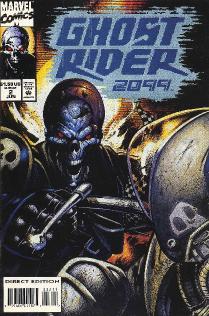Related Research Articles

Marvel 2099 was a Marvel Comics imprint, started in 1992, that was originally about one possible future of the Marvel Universe, but later revealed to be the Earth of the main Marvel continuity in the distant future. It was originally announced by Stan Lee in his "Stan's Soapbox" column as a single series entitled The Marvel World of Tomorrow, which was being developed by Lee and John Byrne. This later changed to a line of books under the banner Marvel 2093 before finally being published as Marvel 2099.

X-Men vs. Street Fighter is a crossover fighting video game developed and published by Capcom. It is Capcom's third fighting game to feature Marvel Comics characters, following X-Men: Children of the Atom and Marvel Super Heroes, and is the first installment in the Marvel vs. Capcom series. As the title suggests, the game includes characters from Marvel's X-Men franchise and the cast from Capcom's Street Fighter series. Originally released as a coin-operated arcade game in 1996, it was ported to the Sega Saturn in 1997 and the PlayStation in 1998.
Nintendo Space World, formerly named Shoshinkai and Famicom Space World, was an annual video game trade show hosted by Nintendo from 1989 to 2001. Its three days of high-energy party atmosphere was the primary venue for Nintendo and its licensees to announce and demonstrate new consoles, accessories, and games. Anticipated and dissected each year with hype and exclusivity, it was a destination for the international video game press, with detailed developer interviews and technology demos.
Marvel Super Heroes is a fighting video game developed by Capcom. Originally released in the arcade in 1995 on the CPS-2 arcade system, it was ported to the Sega Saturn and PlayStation in late 1997. The game, alongside Marvel vs. Capcom: Clash of Super Heroes, was also included in the Marvel vs. Capcom Origins collection, released digitally for the PlayStation 3 and Xbox 360 in September 2012.

Spider-Man 2099 is a superhero appearing in American comic books published by Marvel Comics. The character was created by Peter David and Rick Leonardi in 1992 for the Marvel 2099 comic book line, and he is a futuristic re-imagining of the original Spider-Man created by Stan Lee and Steve Ditko. His true identity is Miguel O'Hara, an Irish-Mexican geneticist living in Nueva York in the year 2099 who attempts to re-create the abilities of the original Spider-Man in other people and later suffers a related accident that causes half of his DNA to be rewritten with a spider's genetic code.

Fighting Force is a 1997 3D brawler developed by Core Design and published by Eidos. It was released for PlayStation, Microsoft Windows, and Nintendo 64 on 15 October 1997. Announced shortly after Core became a star developer through the critical and commercial success of Tomb Raider, Fighting Force was highly anticipated but met with mixed reviews.
Maximum Surge is a cancelled video game by Digital Pictures. Planned for release in 1996 for the 3DO, Mac, PC and Sega Saturn, it was to feature full-motion video in the same way that many of Digital Pictures' releases of the time did. The game's 90 minutes of video footage starred Walter Koenig and Yasmine Bleeth, was directed by William Mesa, and was written by J. Garrett Glover and Charlie Ogden.

Virtua Fighter 3 is the sequel to 1994's Virtua Fighter 2 and the third fighting game in the Virtua Fighter series, developed by Sega AM2 and published by Sega in 1996. It was the first arcade game to run on the Sega Model 3 system board.

Official U.S. PlayStation Magazine was a monthly video game magazine, published by Ziff Davis Media. It was a sister publication of Electronic Gaming Monthly. The magazine focused exclusively on PlayStation hardware, software, and culture, covering the original PlayStation, PlayStation 2, PlayStation 3 and PlayStation Portable. Each issue included a disc that contained playable demos and videos of PlayStation games. The magazine had a nearly ten-year run. The first issue, cover dated October 1997, was published September 23, 1997, while the final issue was cover dated January 2007.

Doom 2099 is a fictional anti-hero appearing in American comic books published by Marvel Comics. The character was primarily featured in the Marvel 2099 series Doom 2099. The character is based on Doctor Doom, created by Stan Lee and Jack Kirby. The series was written by John Francis Moore for its first two years, and by Warren Ellis for its third.

X-Men 2: Clone Wars is a 1995 platform game developed by Headgames and released by Sega of America for the Mega Drive/Genesis as a sequel to the 1993's X-Men. The game is based on the adventures of the Marvel Comics superhero team, the X-Men. A sequel, titled X-Women, was cancelled.

Ghost Rider 2099 is a comic book series that was published by Marvel Comics, under the Marvel 2099 imprint, from 1994 to 1996.

The Punisher is a 1993 beat 'em up arcade game developed and released by Capcom. It stars the Marvel Comics' antihero the Punisher and co-stars S.H.I.E.L.D. agent Nick Fury as the second player's character as they embark on a mission to kill the crime lord the Kingpin and bring down his organization. While following the same general formula as Capcom's previous beat 'em ups, the game has a range of usable weapons and a comics-style presentation.

Dark Reign is a 2008 to 2009 comic book branding used by Marvel Comics. It deals with the aftermath of the "Secret Invasion" storyline, which leads to a shift of power in the Marvel Universe toward Norman Osborn. The title refers to Osborn's rise to national power and the ramifications thereof. Joe Quesada, then-editor-in-chief of Marvel Comics, stated that "Dark Reign is not really an event, it's what's happening in the Marvel Universe." He believes that "Dark Reign leads to an interesting place in the Marvel Universe. I think you'll see a pulling back at the end of Dark Reign, but you'll understand at the end of it what we were trying to get to."
X-Women: The Sinister Virus is an unreleased side-scrolling action video game that was in development by Clockwork Tortoise and planned to be published by Sega on a scheduled January 1997 release date exclusively for the Sega Genesis. Based on the popular X-Men Marvel Comics superheroes, it is inspired by the long-running comic book mythology and adaptations in other media. In the main storyline, a plot to incapacitate all male mutants by inflicting a disease known as the Genesis Virus upon them was orchestrated by Mister Sinister, leaving only the X-Women to scour through Earth in order to find the remaining viruses and develop a cure.
Zero Racers is an unreleased racing video game that was in development and planned to be published by Nintendo on a scheduled 1996 release date exclusively for the Virtual Boy. Had it been released prior to cancellation, it would have become the first F-Zero installment to have featured 3D graphics. In the game, players can choose between one of four characters, each with their respective hovercar and race against AI-controlled characters in fifteen tracks divided into three leagues. The title was previewed in video game magazines, erroneously reported to have appeared at E3 1996, but it was ultimately shelved due to the failure of the Virtual Boy itself, despite being completed for release. According to a Nintendo of America employee, the game was complete, having been rated by the ESRB and materials having been made for a physical release.
References
- ↑ Video Game Graveyard: Marvel 2099
- ↑ "Marvel 2099". Electronic Gaming Monthly . No. 84. Ziff Davis. July 1996. p. 69.
- ↑ "Marvel 2099". Electronic Gaming Monthly . No. 85. Ziff Davis. August 1996. p. 83.
- ↑ "Layoffs Hit Mindscape". GamePro . No. 101. IDG. February 1997. pp. 26–27.